From the Trenches
Mesolithic Markings
By DANIEL WEISS
Monday, April 11, 2016
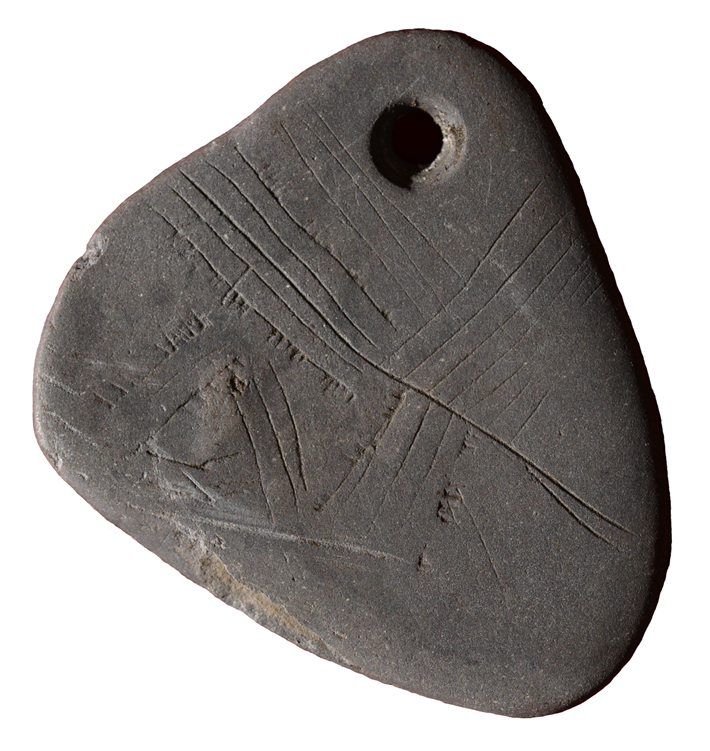 An 11,000-year-old shale pendant engraved with an enigmatic network of lines has been discovered at Star Carr in North Yorkshire, England. The Mesolithic site was among the first in the British Isles to have been permanently settled after the end of the last Ice Age, during which Britain was likely depopulated. The engravings are similar to those found on amber pendants from the same period in Denmark, which was then accessible by land from Britain. Researchers believe the engravings may depict a tree, a map, a leaf, or tally marks. “Personally, I’m happiest with the idea that they’re counting something,” says Nicky Milner of the University of York, “but it’s impossible to say.”
An 11,000-year-old shale pendant engraved with an enigmatic network of lines has been discovered at Star Carr in North Yorkshire, England. The Mesolithic site was among the first in the British Isles to have been permanently settled after the end of the last Ice Age, during which Britain was likely depopulated. The engravings are similar to those found on amber pendants from the same period in Denmark, which was then accessible by land from Britain. Researchers believe the engravings may depict a tree, a map, a leaf, or tally marks. “Personally, I’m happiest with the idea that they’re counting something,” says Nicky Milner of the University of York, “but it’s impossible to say.”
Islam North of the Pyrenees
By DANIEL WEISS
Monday, April 11, 2016
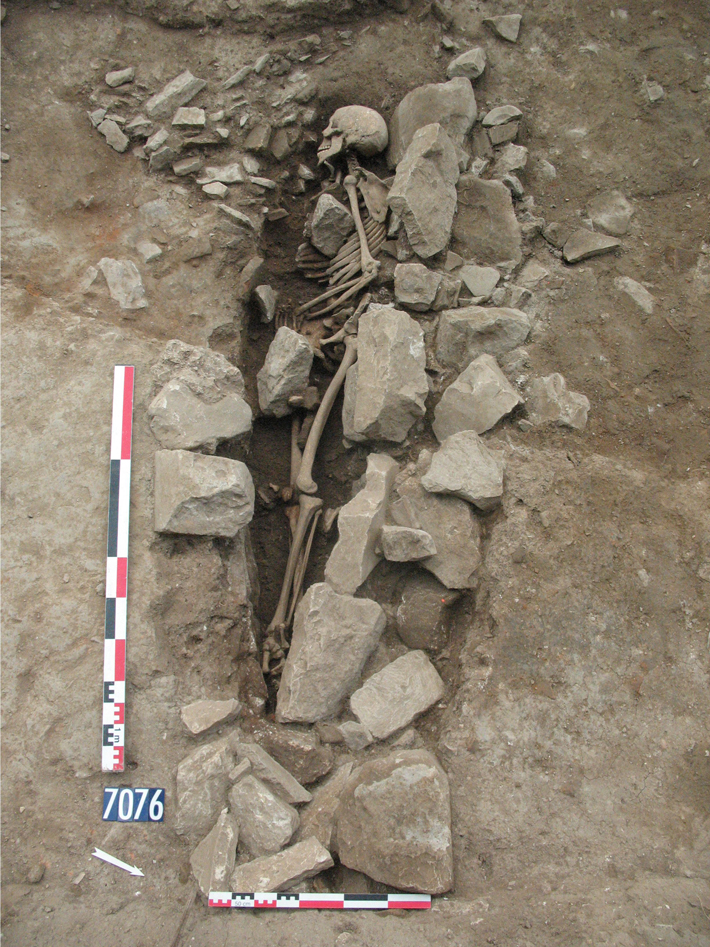 In the eighth century A.D., the Umayyad Islamic caliphate conquered the Visigothic Kingdom, which occupied the Iberian Peninsula and southwestern France. The Muslim presence in Spain and Portugal during this period is well documented, but evidence from north of the Pyrenees has been scant. Now archaeologists believe they have found three Muslim burials in Nimes, France, that date to this period. “The presence of Muslim burials suggests the existence of a Muslim community,” says Yves Gleize of the French National Institute of Preventive Archaeological Research.
In the eighth century A.D., the Umayyad Islamic caliphate conquered the Visigothic Kingdom, which occupied the Iberian Peninsula and southwestern France. The Muslim presence in Spain and Portugal during this period is well documented, but evidence from north of the Pyrenees has been scant. Now archaeologists believe they have found three Muslim burials in Nimes, France, that date to this period. “The presence of Muslim burials suggests the existence of a Muslim community,” says Yves Gleize of the French National Institute of Preventive Archaeological Research.
In accordance with Muslim burial practices, all three bodies were buried on their right sides, facing southeast toward Mecca, and in one case the arrangement of bones suggests that the body was wrapped in a shroud upon burial. Genetic analysis shows that all three individuals had North African paternal ancestry, leading the researchers to conjecture that they were Berber soldiers, who made up a large portion of the Umayyad forces that conquered the Visigoths.
What Happened After 1492?
By ERIC A. POWELL
Monday, April 11, 2016
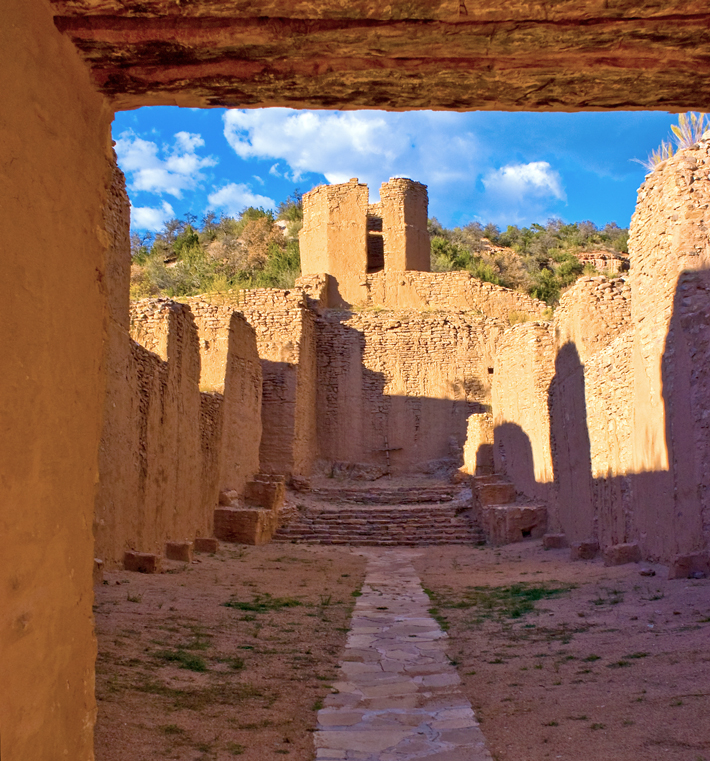 No one disputes that European colonization of the New World devastated native populations. But the timing and scale of that demographic crash are sources of debate among archaeologists and historians. Some believe that Old World diseases, for which Native Americans had no resistance, spread even faster than explorers and colonists, in some regions wiping out peoples before they had any direct contact with Europeans. A team led by Harvard University archaeologist Matthew Liebmann has now tested that hypothesis in northern New Mexico, which the Spanish first reached in 1539. Using lidar images of 18 ruined villages once occupied by the Jemez people, the team estimated the population of these Puebloans through time. They found that it was stable throughout the sixteenth century—well after the first Spaniards arrived in New Mexico. “In this part of the Southwest, massive pandemics did not arrive ahead of or with the initial Spanish occupation,” says Liebmann.
No one disputes that European colonization of the New World devastated native populations. But the timing and scale of that demographic crash are sources of debate among archaeologists and historians. Some believe that Old World diseases, for which Native Americans had no resistance, spread even faster than explorers and colonists, in some regions wiping out peoples before they had any direct contact with Europeans. A team led by Harvard University archaeologist Matthew Liebmann has now tested that hypothesis in northern New Mexico, which the Spanish first reached in 1539. Using lidar images of 18 ruined villages once occupied by the Jemez people, the team estimated the population of these Puebloans through time. They found that it was stable throughout the sixteenth century—well after the first Spaniards arrived in New Mexico. “In this part of the Southwest, massive pandemics did not arrive ahead of or with the initial Spanish occupation,” says Liebmann.
But the study also showed that the founding of a mission church near the Jemez almost a hundred years later had deadly consequences. Liebmann found that the population dropped by almost 90 percent between 1620 and 1640, probably as a result of sustained contact with disease-ridden livestock from the mission. His team also discovered that the number of fires in the area began to increase after this time, probably a consequence of forest regrowth following the drastic depopulation.
Women in a Temple of Death
By ROGER ATWOOD
Monday, April 11, 2016
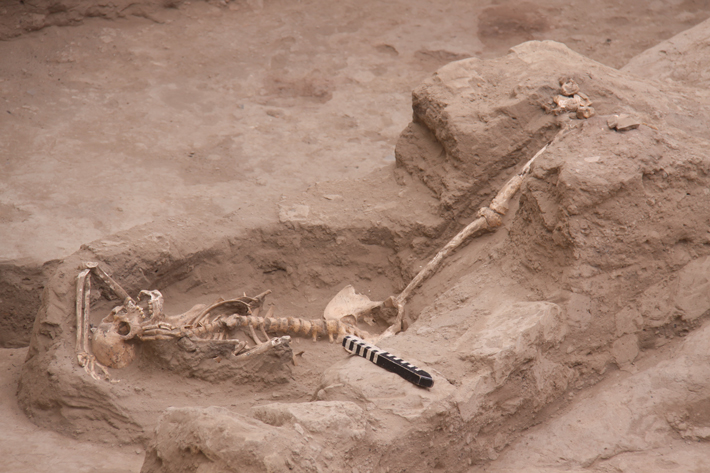 Archaeologists have long known that ancient societies on Peru’s north coast killed male prisoners of war and drank their blood in grisly sacrifice ceremonies. Now researchers have found an unusual twist on that scene: the remains of six young women, sacrificed in a ritual in about A.D. 850. Their bones were found under the floor of a mudbrick temple complex in Pucalá, near the city of Chiclayo. The women show no signs of disease and had been wrenched into odd positions. Four lay atop each other in a single grave, and two others rested a few feet away, accompanied by a baby llama. Most are missing rib bones, indicating that their remains were left exposed and that their organs had been eaten by vultures after death, a “purification rite” that the bodies of male sacrifice victims were also subjected to, says archaeologist Edgar Bracamonte of the Royal Tombs of Sipán Museum.
Archaeologists have long known that ancient societies on Peru’s north coast killed male prisoners of war and drank their blood in grisly sacrifice ceremonies. Now researchers have found an unusual twist on that scene: the remains of six young women, sacrificed in a ritual in about A.D. 850. Their bones were found under the floor of a mudbrick temple complex in Pucalá, near the city of Chiclayo. The women show no signs of disease and had been wrenched into odd positions. Four lay atop each other in a single grave, and two others rested a few feet away, accompanied by a baby llama. Most are missing rib bones, indicating that their remains were left exposed and that their organs had been eaten by vultures after death, a “purification rite” that the bodies of male sacrifice victims were also subjected to, says archaeologist Edgar Bracamonte of the Royal Tombs of Sipán Museum.
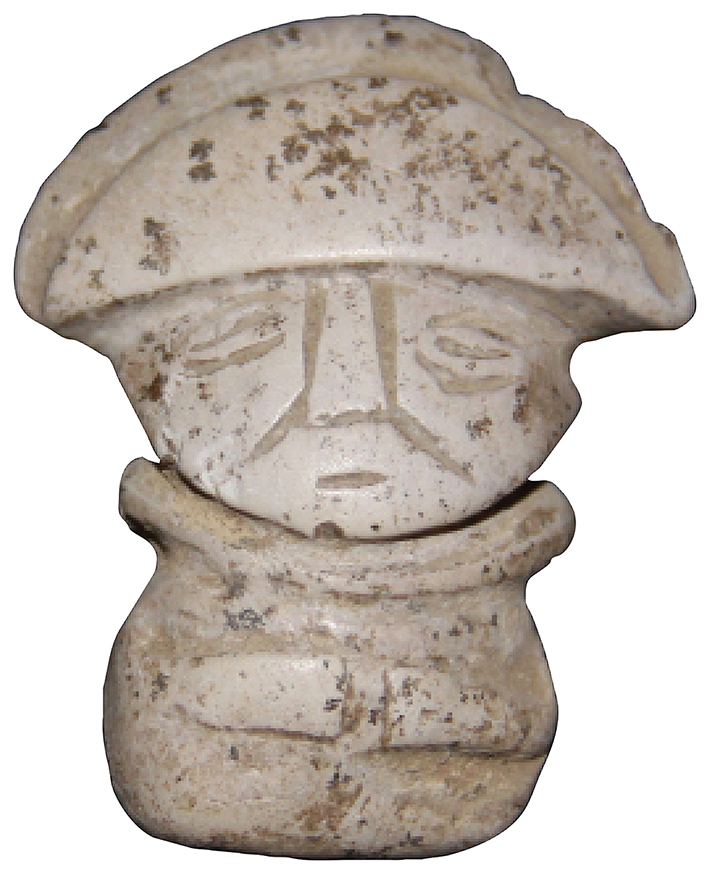 Human sacrifices were often public spectacles in ancient Peru, but not in this case. “They were buried in a ritual space that was surrounded by high walls, indicating a private context,” Bracamonte says. The burial occurred “at a time of great ideological change,” he adds, when the old Moche culture was yielding to a new order, known as Lambayeque. The Moche buried their dead on a north-south axis. These women were buried on a careful east-west axis, their heads toward the Andes Mountains to the east. Ceramics accompanying the women are also from the Andes, suggesting that the women and the society that buried them originated in the mountains and came to the coast by invasion or migration.
Human sacrifices were often public spectacles in ancient Peru, but not in this case. “They were buried in a ritual space that was surrounded by high walls, indicating a private context,” Bracamonte says. The burial occurred “at a time of great ideological change,” he adds, when the old Moche culture was yielding to a new order, known as Lambayeque. The Moche buried their dead on a north-south axis. These women were buried on a careful east-west axis, their heads toward the Andes Mountains to the east. Ceramics accompanying the women are also from the Andes, suggesting that the women and the society that buried them originated in the mountains and came to the coast by invasion or migration.
The Price of Tea in China
By LARA FARRAR
Monday, April 11, 2016
 Archaeologists have identified what they believe is the earliest archaeological evidence of the consumption of tea: plant remains in two tombs excavated in Tibet and Chang’an, today called Xi’an, a city that marks the beginning of the Silk Road in northern China. The finds contain traces of caffeine and theanine—substances particularly characteristic of tea. The tombs are more than 2,000 years old, indicating the beverage was consumed during the Han Dynasty (206 B.C.–A.D. 220). A Chinese document from 59 B.C. that mentions a drink that might be tea was previously the earliest known record of the beverage. Tea does not grow near the tombs, so the discovery indicates that the Silk Road was a “much more complicated and complex long-distance trade network than was known from written sources,” says researcher Dorian Fuller, an archaeobotany professor at University College London. Tea-producing regions, including remote areas of China and even Myanmar, he adds, had “well established supply lines” feeding into the Silk Road.
Archaeologists have identified what they believe is the earliest archaeological evidence of the consumption of tea: plant remains in two tombs excavated in Tibet and Chang’an, today called Xi’an, a city that marks the beginning of the Silk Road in northern China. The finds contain traces of caffeine and theanine—substances particularly characteristic of tea. The tombs are more than 2,000 years old, indicating the beverage was consumed during the Han Dynasty (206 B.C.–A.D. 220). A Chinese document from 59 B.C. that mentions a drink that might be tea was previously the earliest known record of the beverage. Tea does not grow near the tombs, so the discovery indicates that the Silk Road was a “much more complicated and complex long-distance trade network than was known from written sources,” says researcher Dorian Fuller, an archaeobotany professor at University College London. Tea-producing regions, including remote areas of China and even Myanmar, he adds, had “well established supply lines” feeding into the Silk Road.
Advertisement
Advertisement
IN THIS ISSUE
From the Trenches
Dressing for the Ages
Off the Grid
Let a Turtle Be Your Psychopomp
The Price of Tea in China
What Happened After 1492?
Women in a Temple of Death
Islam North of the Pyrenees
Mesolithic Markings
Vikings, Worms, and Emphysema
Medieval River Engineering
The Death of Joe the Quilter
Egypt’s Immigrant Elite
The First Casus Belli
Artifact
The Wild Man of the medieval world
Advertisement

Recent Issues
-
 May/June 2024
May/June 2024
-
 March/April 2024
March/April 2024
-
 January/February 2024
January/February 2024
-
 November/December 2023
November/December 2023
-
 September/October 2023
September/October 2023
-
 July/August 2023
July/August 2023
-
 May/June 2023
May/June 2023
-
 March/April 2023
March/April 2023
-
 January/February 2023
January/February 2023
-
 November/December 2022
November/December 2022
-
 September/October 2022
September/October 2022
-
 July/August 2022
July/August 2022
-
 May/June 2022
May/June 2022
-
 March/April 2022
March/April 2022
-
 January/February 2022
January/February 2022
-
 November/December 2021
November/December 2021
-
 September/October 2021
September/October 2021
-
 July/August 2021
July/August 2021
-
 May/June 2021
May/June 2021
-
 March/April 2021
March/April 2021
-
 January/February 2021
January/February 2021
-
 November/December 2020
November/December 2020
-
 September/October 2020
September/October 2020
-
 July/August 2020
July/August 2020
-
 May/June 2020
May/June 2020
-
 March/April 2020
March/April 2020
-
 January/February 2020
January/February 2020
-
 November/December 2019
November/December 2019
-
 September/October 2019
September/October 2019
-
 July/August 2019
July/August 2019
-
 May/June 2019
May/June 2019
-
 March/April 2019
March/April 2019
-
 January/February 2019
January/February 2019
-
 November/December 2018
November/December 2018
-
 September/October 2018
September/October 2018
-
 July/August 2018
July/August 2018
-
 May/June 2018
May/June 2018
-
 March/April 2018
March/April 2018
-
 January/February 2018
January/February 2018
-
 November/December 2017
November/December 2017
-
 September/October 2017
September/October 2017
-
 July/August 2017
July/August 2017
-
 May/June 2017
May/June 2017
-
 March/April 2017
March/April 2017
-
 January/February 2017
January/February 2017
-
 November/December 2016
November/December 2016
-
 September/October 2016
September/October 2016
-
 July/August 2016
July/August 2016
-
 May/June 2016
May/June 2016
-
 March/April 2016
March/April 2016
-
 January/February 2016
January/February 2016
-
 November/December 2015
November/December 2015
-
 September/October 2015
September/October 2015
-
 July/August 2015
July/August 2015
-
 May/June 2015
May/June 2015
-
 March/April 2015
March/April 2015
-
 January/February 2015
January/February 2015
-
 November/December 2014
November/December 2014
-
 September/October 2014
September/October 2014
-
 July/August 2014
July/August 2014
-
 May/June 2014
May/June 2014
-
 March/April 2014
March/April 2014
-
 January/February 2014
January/February 2014
-
 November/December 2013
November/December 2013
-
 September/October 2013
September/October 2013
-
 July/August 2013
July/August 2013
-
 May/June 2013
May/June 2013
-
 March/April 2013
March/April 2013
-
 January/February 2013
January/February 2013
-
 November/December 2012
November/December 2012
-
 September/October 2012
September/October 2012
-
 July/August 2012
July/August 2012
-
 May/June 2012
May/June 2012
-
 March/April 2012
March/April 2012
-
 January/February 2012
January/February 2012
-
 November/December 2011
November/December 2011
-
 September/October 2011
September/October 2011
-
 July/August 2011
July/August 2011
-
 May/June 2011
May/June 2011
-
 March/April 2011
March/April 2011
-
 January/February 2011
January/February 2011
Advertisement






